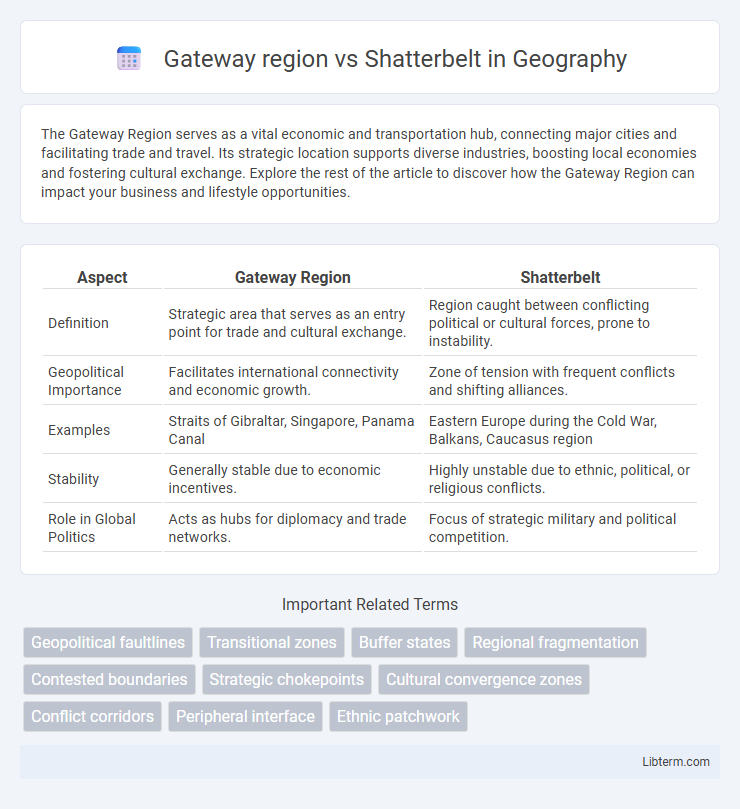The Gateway Region serves as a vital economic and transportation hub, connecting major cities and facilitating trade and travel. Its strategic location supports diverse industries, boosting local economies and fostering cultural exchange. Explore the rest of the article to discover how the Gateway Region can impact your business and lifestyle opportunities.
Table of Comparison
| Aspect | Gateway Region | Shatterbelt |
|---|---|---|
| Definition | Strategic area that serves as an entry point for trade and cultural exchange. | Region caught between conflicting political or cultural forces, prone to instability. |
| Geopolitical Importance | Facilitates international connectivity and economic growth. | Zone of tension with frequent conflicts and shifting alliances. |
| Examples | Straits of Gibraltar, Singapore, Panama Canal | Eastern Europe during the Cold War, Balkans, Caucasus region |
| Stability | Generally stable due to economic incentives. | Highly unstable due to ethnic, political, or religious conflicts. |
| Role in Global Politics | Acts as hubs for diplomacy and trade networks. | Focus of strategic military and political competition. |
Introduction to Gateway Regions and Shatterbelts
Gateway regions serve as strategic hubs that facilitate trade, cultural exchange, and connectivity between major economic or geopolitical areas. Shatterbelts are volatile regions characterized by fragmented geopolitics, often caught between competing powers, leading to persistent instability and conflict. Understanding the dynamics of gateway regions versus shatterbelts is crucial for analyzing global geopolitical strategies and regional development patterns.
Defining the Gateway Region: Key Characteristics
The Gateway Region serves as a strategic hub connecting multiple economic and cultural zones, characterized by its role as a transit and trade corridor facilitating international exchange. This region typically features diversified infrastructure, robust transportation networks, and a dynamic population that supports cross-border commerce. In contrast to a Shatterbelt, which is defined by political instability and contested borders, the Gateway Region emphasizes connectivity, accessibility, and economic integration.
What is a Shatterbelt? Concept and Features
A shatterbelt is a politically unstable region caught between stronger conflicting external forces, often characterized by fragmented states and frequent conflicts. This concept highlights areas where cultural, ethnic, or ideological divisions are intensified due to pressure from competing powers or alliances. Key features include strategic geopolitical significance, persistent territorial disputes, and high vulnerability to external influence and internal fragmentation.
Historical Context of Gateway Regions and Shatterbelts
Gateway regions have historically served as crucial transit and trade points connecting major civilizations, facilitating cultural exchange and economic interaction across empires such as the Silk Road corridors in Central Asia. Shatterbelts, often located at geopolitical fault lines like the Balkans or the Middle East, have experienced persistent conflict and fragmentation due to competing great power interests and ethnic divisions. The historical context of gateway regions highlights their role in integration and connectivity, whereas shatterbelts underscore volatility and geopolitical instability shaped by historical rivalries and external interference.
Geopolitical Importance: Gateway vs Shatterbelt
Gateway regions serve as strategic access points facilitating trade, cultural exchange, and military movement between distinct geopolitical zones, enhancing connectivity and regional influence. Shatterbelts are areas of persistent conflict and fragmentation due to competing powers and ethnic divisions, often becoming focal points of geopolitical tension and instability. While gateways promote integration and cooperation, shatterbelts represent zones of division with significant implications for security and international relations.
Economic Impacts in Gateway Regions and Shatterbelts
Gateway regions serve as critical economic hubs by facilitating international trade, attracting foreign investment, and promoting regional development through infrastructure connectivity and market access. Shatterbelts, characterized by geopolitical instability, face economic disruptions such as reduced foreign direct investment, damaged infrastructure, and hindered trade flows, limiting growth and development. The contrasting economic impacts highlight gateways' roles in sustaining global commerce while shatterbelts struggle with persistent economic volatility and underinvestment.
Case Studies: Real-World Examples of Each
The Gateway region, exemplified by Istanbul, serves as a vital geopolitical hub connecting Europe and Asia, facilitating economic, cultural, and strategic exchanges that stabilize regional dynamics. In contrast, the Shatterbelt, as seen in the Balkans, experiences persistent ethnic conflicts and political fragmentation due to overlapping interests and external interventions, resulting in chronic instability. These case studies highlight how Gateways foster connectivity and cohesion, whereas Shatterbelts are characterized by division and volatility.
Social and Cultural Dynamics in Both Regions
Gateway regions foster diverse social integration and cultural exchange due to high connectivity and migration influx, resulting in dynamic multicultural societies with hybrid identities. Shatterbelt areas experience fragmented social structures and cultural tensions, marked by ethnic conflicts and shifting alliances influenced by geopolitical instability. The contrasting social cohesiveness in gateway regions versus the volatility in shatterbelts highlights the impact of political geography on cultural evolution and community resilience.
Challenges and Opportunities: Gateway Region versus Shatterbelt
The Gateway region faces challenges such as managing rapid economic growth and infrastructure demands while leveraging its strategic location for trade and investment opportunities. In contrast, Shatterbelt areas struggle with geopolitical instability and ethnic conflicts but offer unique prospects for cross-cultural exchange and resource exploitation. Both regions require tailored policies to address their distinct vulnerabilities while capitalizing on their potential for regional development and international cooperation.
Conclusion: Future Trends and Strategic Implications
Gateway regions will increasingly serve as vital hubs for global trade and cultural exchange, driven by digital infrastructure advancements and strategic geopolitical positioning. Shatterbelts, characterized by persistent geopolitical tensions and fragmented governance, will require adaptive diplomacy and conflict mitigation to stabilize regional dynamics. Strategic implications emphasize fostering resilient supply chains and multilateral cooperation to navigate the complex interplay between Gateway regions' growth and Shatterbelt volatility.
Gateway region Infographic

 libterm.com
libterm.com